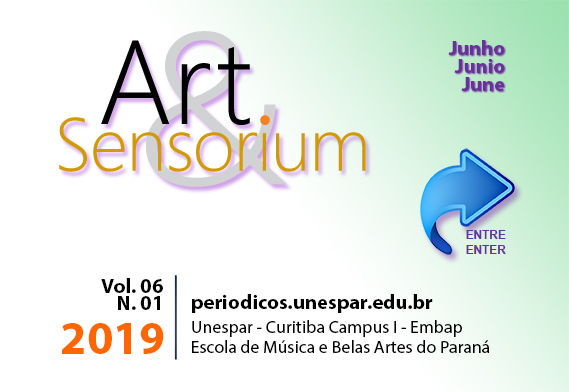Arte híbrida, computação e espaço: da zero-dimensionalidade à multidimensionalidade
DOI:
https://doi.org/10.33871/23580437.2019.6.1.066-078Keywords:
Arte, Tecnologia, Som, Imagem, Espaço.Abstract
O presente texto possui como proposta explorar as relações entre som, imagem e espaço em processos artísticos realizados a partir do uso de tecnologias eletrônicas e computacionais. Partindo da concepção de aparelho na teoria do filósofo Vilém Flusser, observa-se o uso de diferentes tecnologias enquanto suportes que possibilitam a convergência do audível e do visível. O texto investiga como, em certos processos artísticos, as tecnologias eletrônicas foram fragmentadas e remontadas com intuito de criar máquinas que produzem percepções de espaço e tempo singulares. Neste contexto, o computador é observado como máquina multimídia capaz de produzir a convergência entre diversos meios e materiais, possibilitando a geração de espaços multidimensionais. Destaca-se, deste modo, que no século XXI a arte incorpora a tecnologia enquanto metalinguagem, evocando processos de singularização do imaginário.
Downloads
Downloads
Published
Issue
Section
License
Copyright (c) 2022 International Interdisciplinary Journal of Visual Arts - Art&Sensorium

This work is licensed under a Creative Commons Attribution 3.0 Unported License.
Authors who publish with this journal agree to the following terms:- Authors retain copyright and grant the journal right of first publication with the work simultaneously licensed under a Creative Commons Attribution License that allows others to share the work with an acknowledgement of the work's authorship and initial publication in this journal.
- Authors are able to enter into separate, additional contractual arrangements for the non-exclusive distribution of the journal's published version of the work (e.g., post it to an institutional repository or publish it in a book), with an acknowledgement of its initial publication in this journal.
- Authors are permitted and encouraged to post their work online (e.g., in institutional repositories or on their website) prior to and during the submission process, as it can lead to productive exchanges, as well as earlier and greater citation of published work (See The Effect of Open Access).


